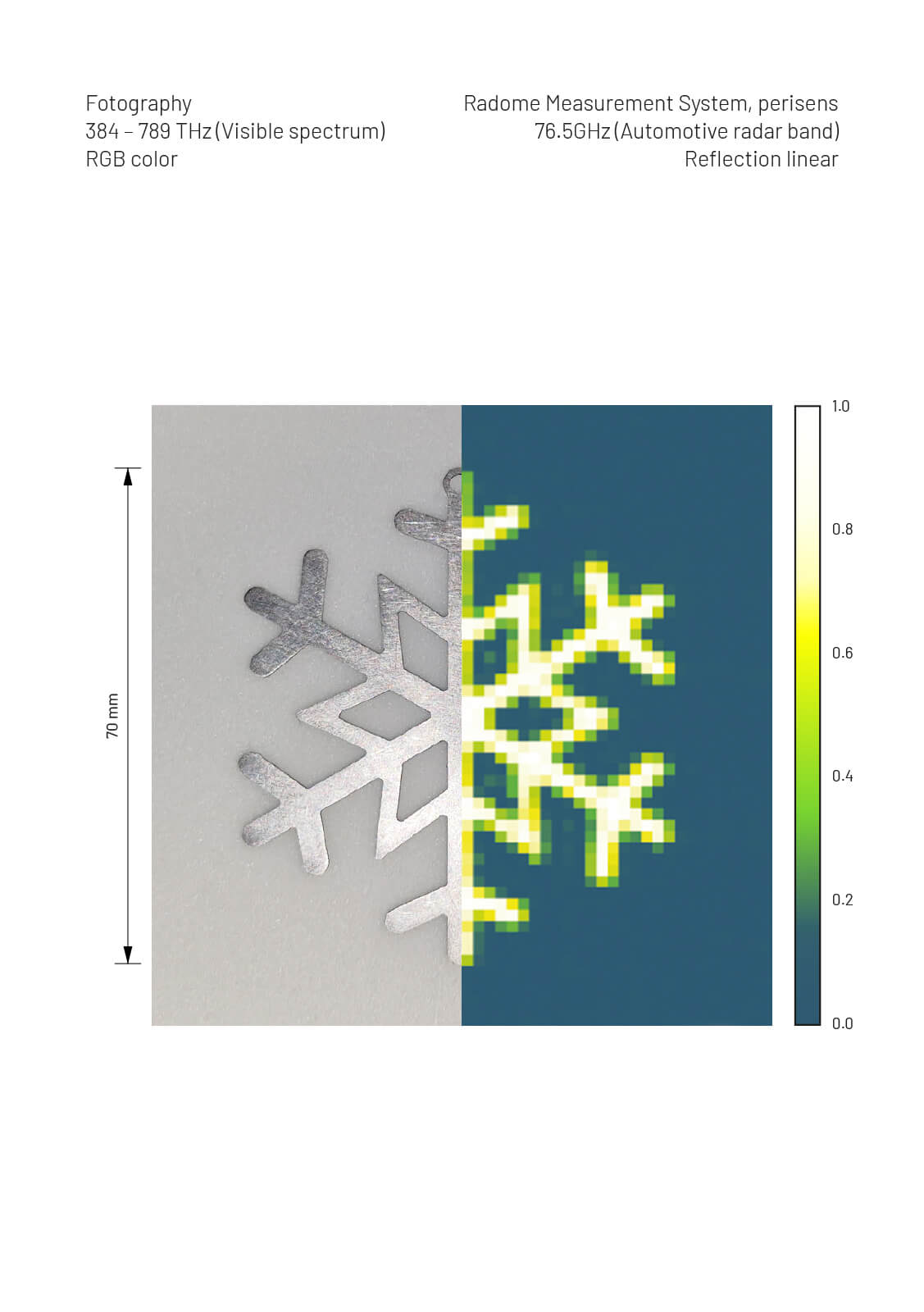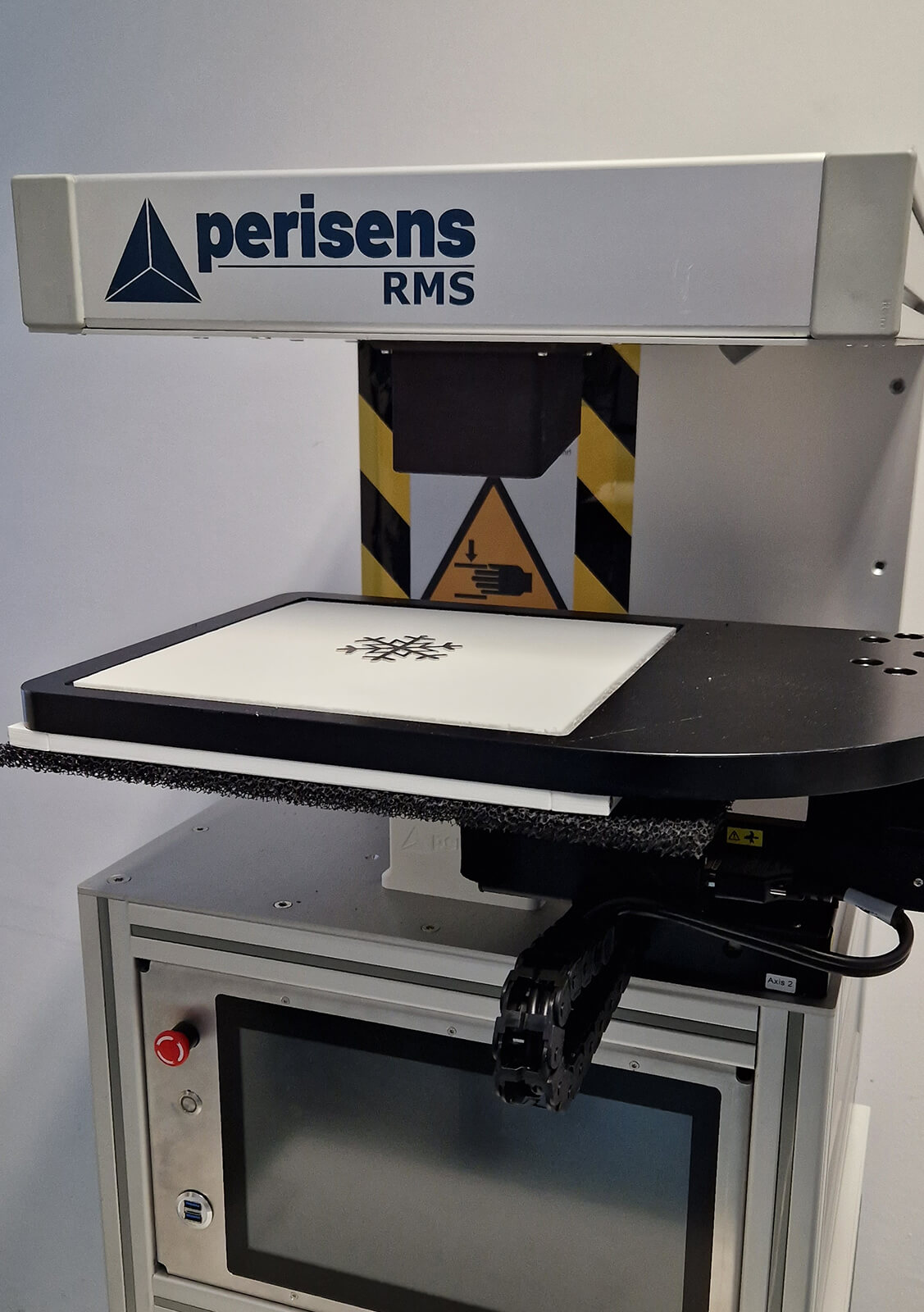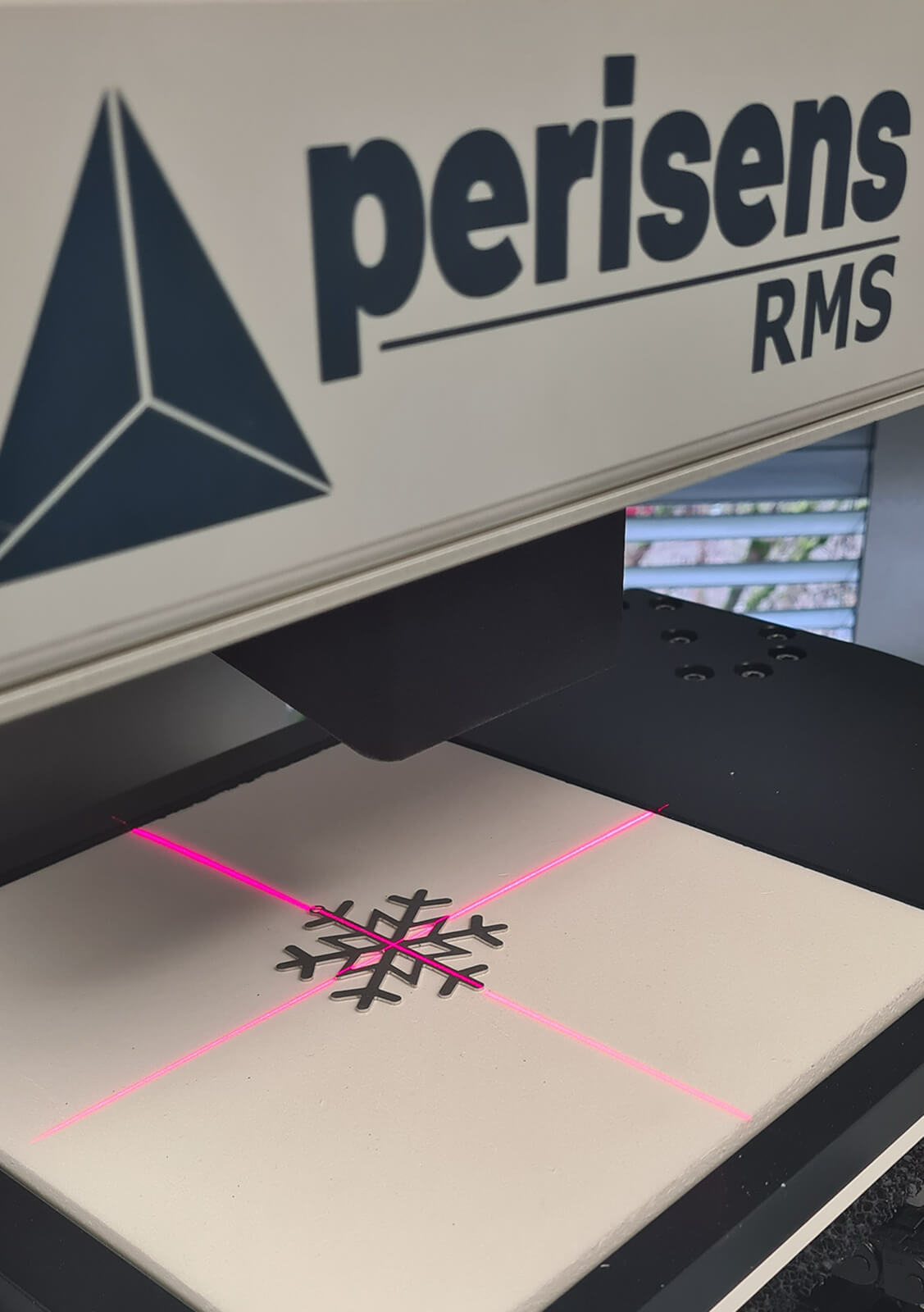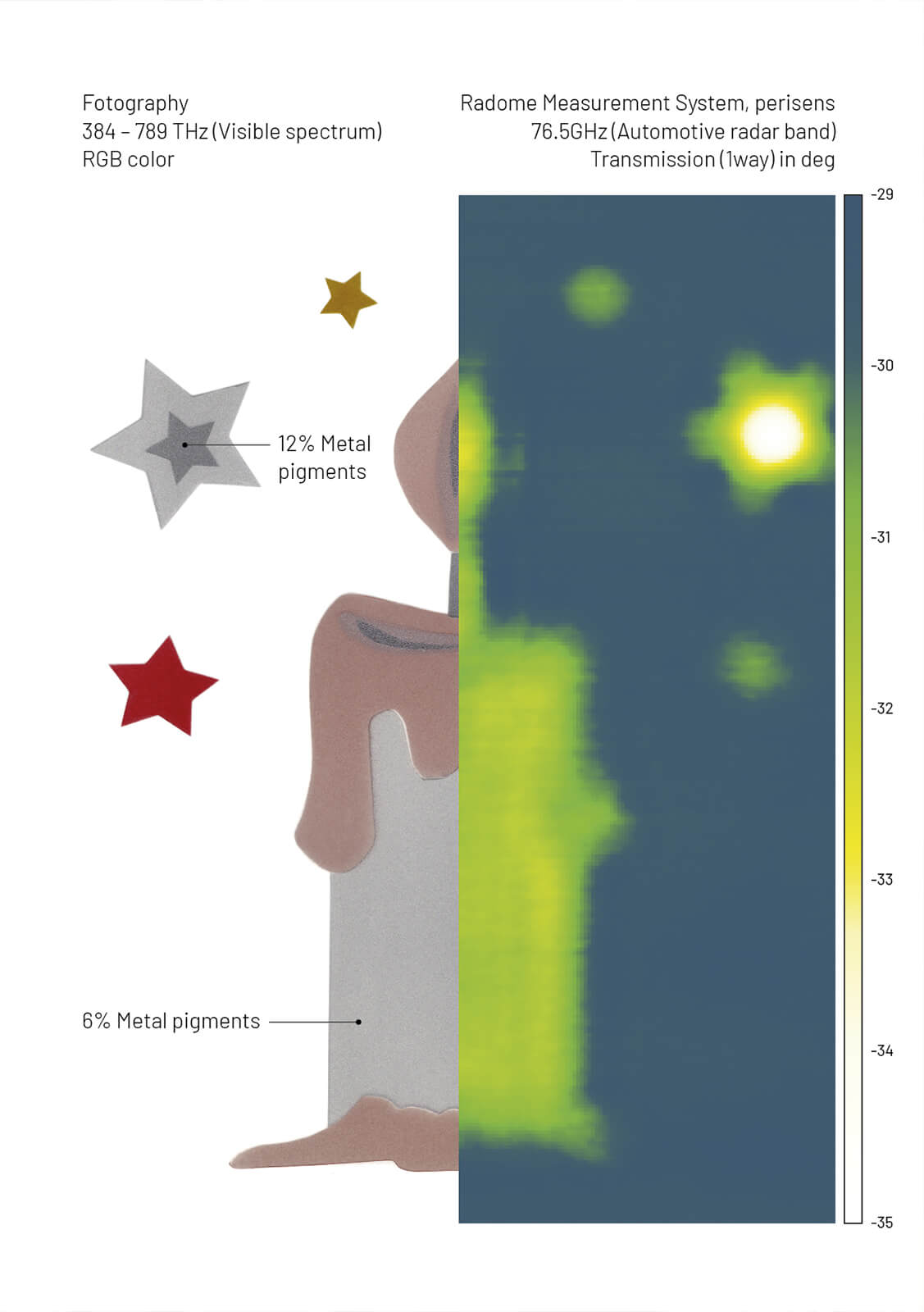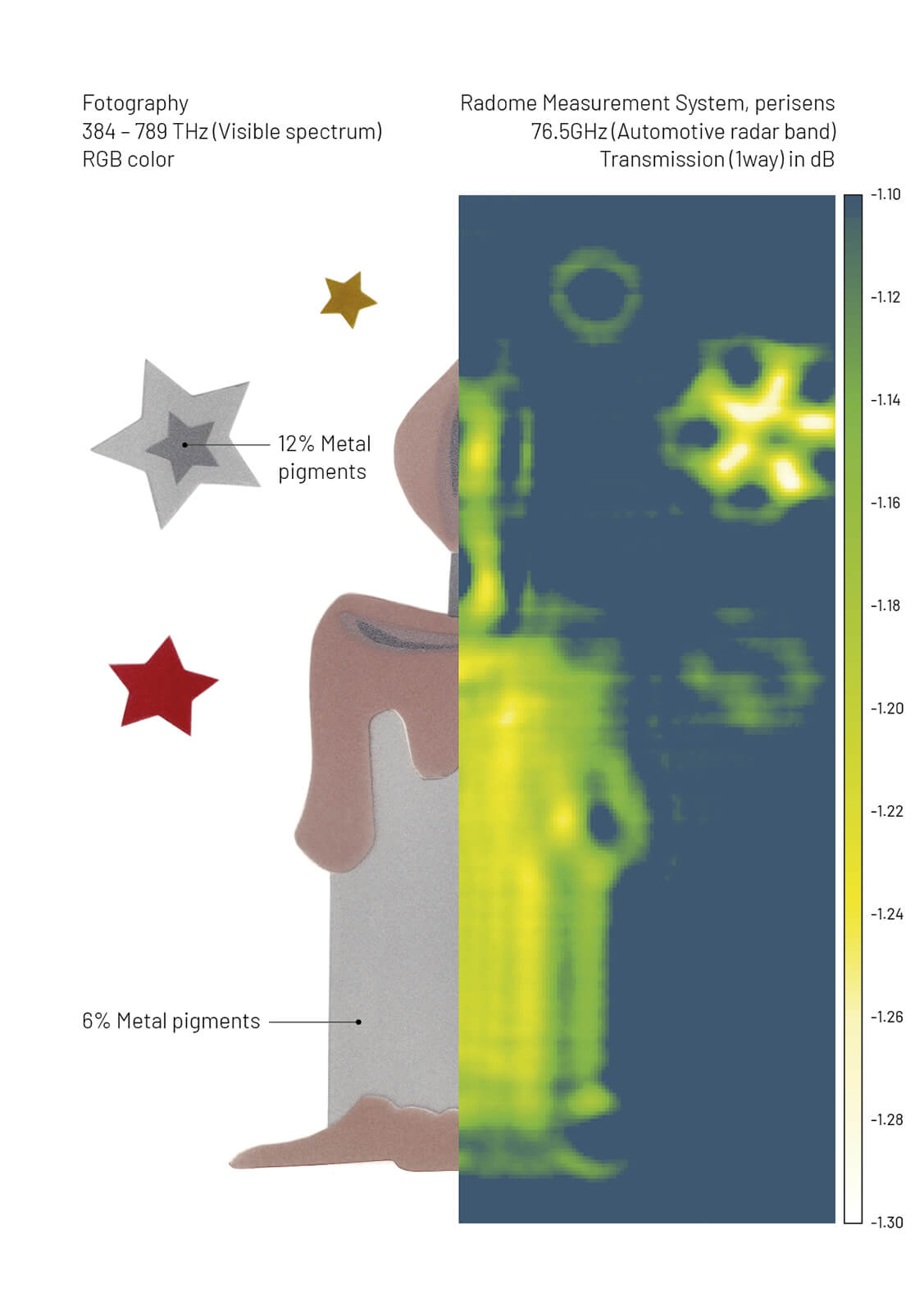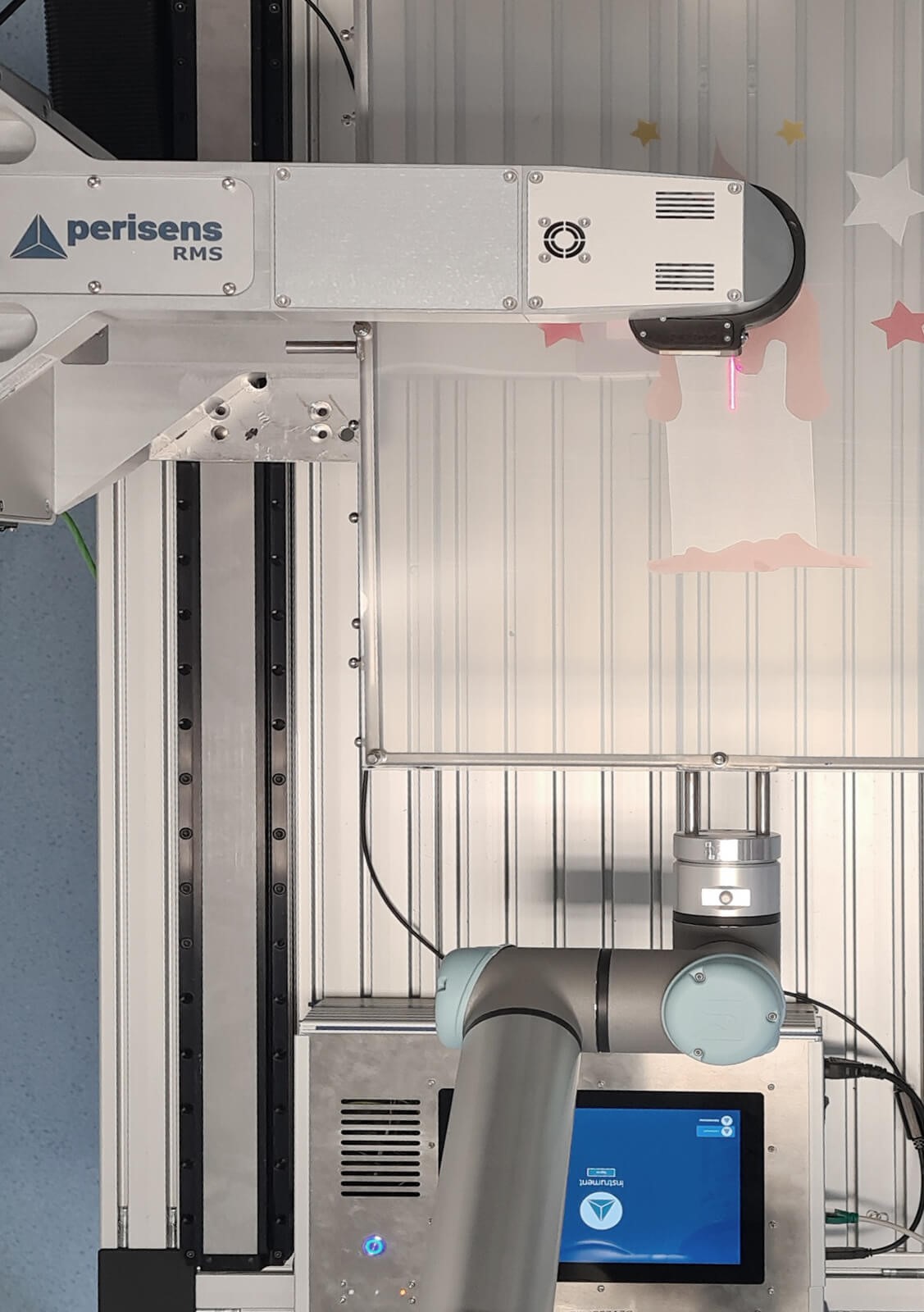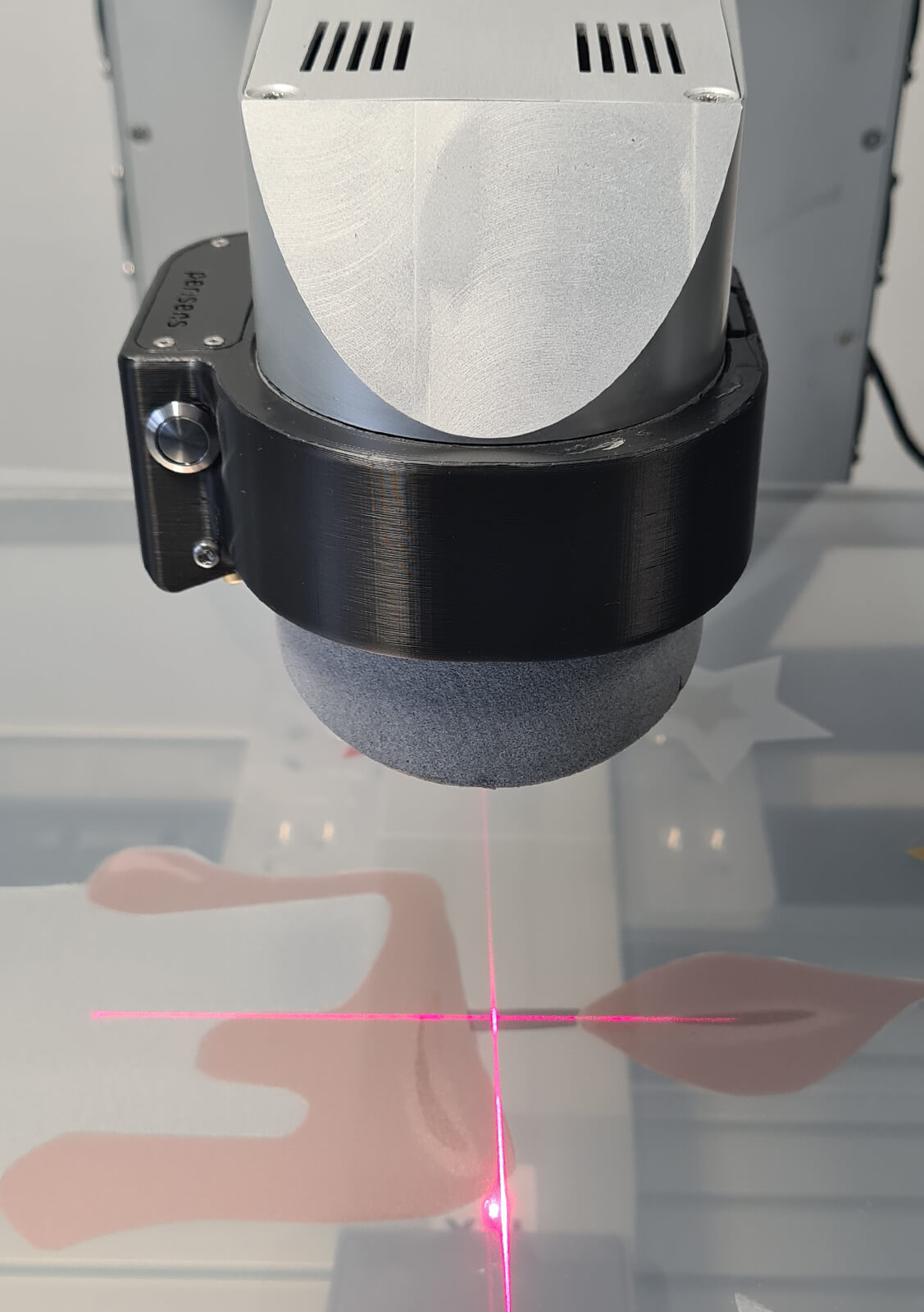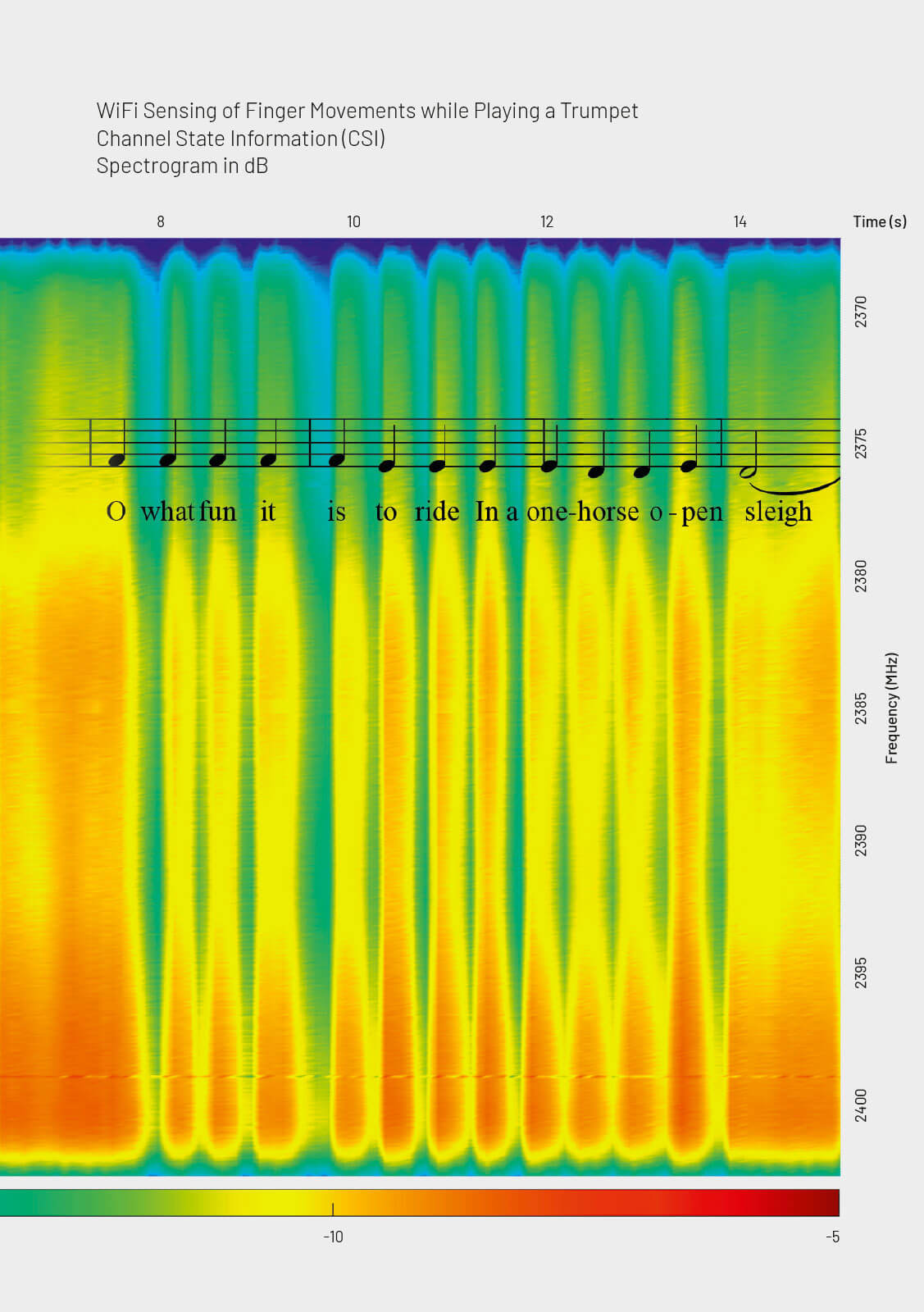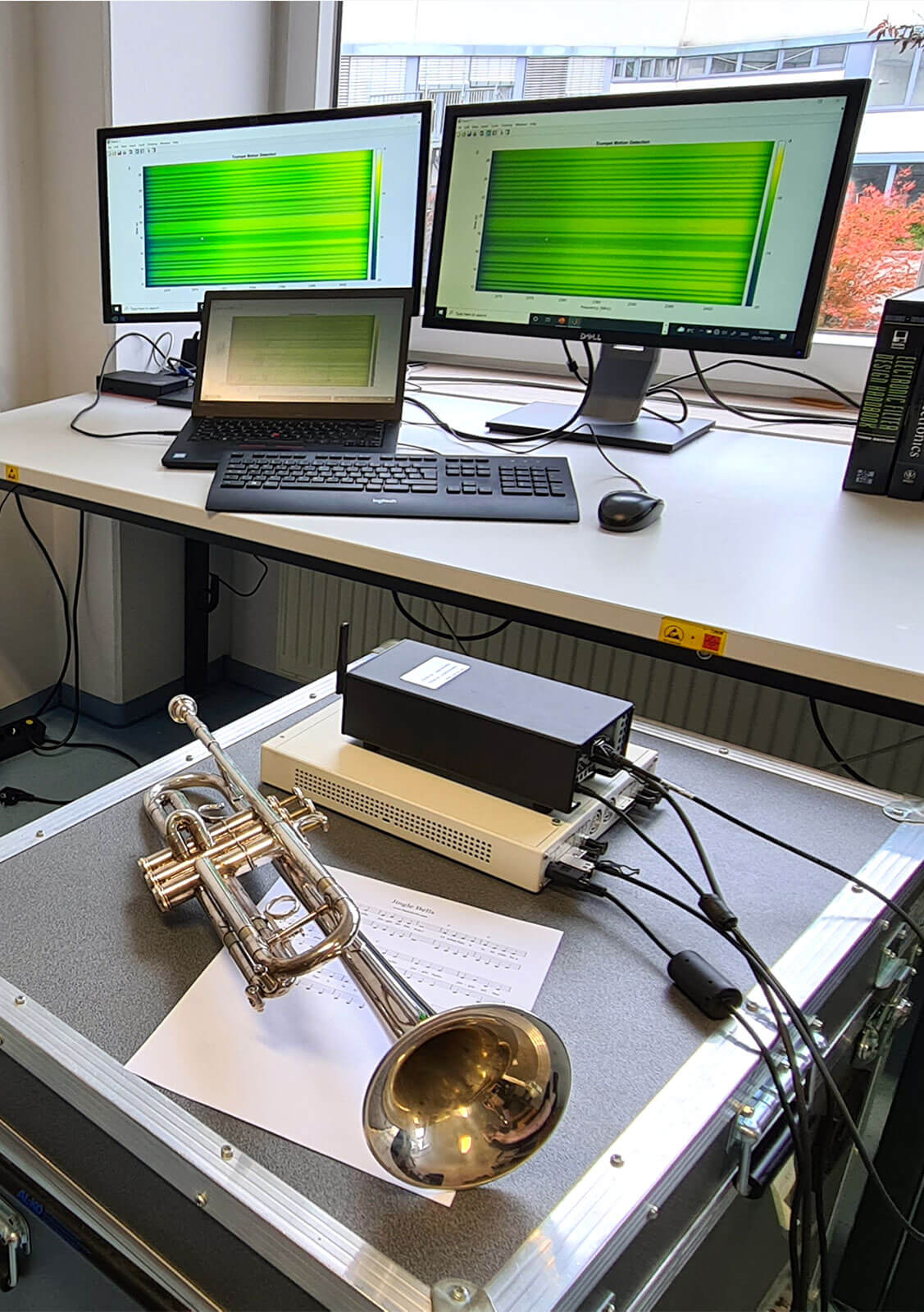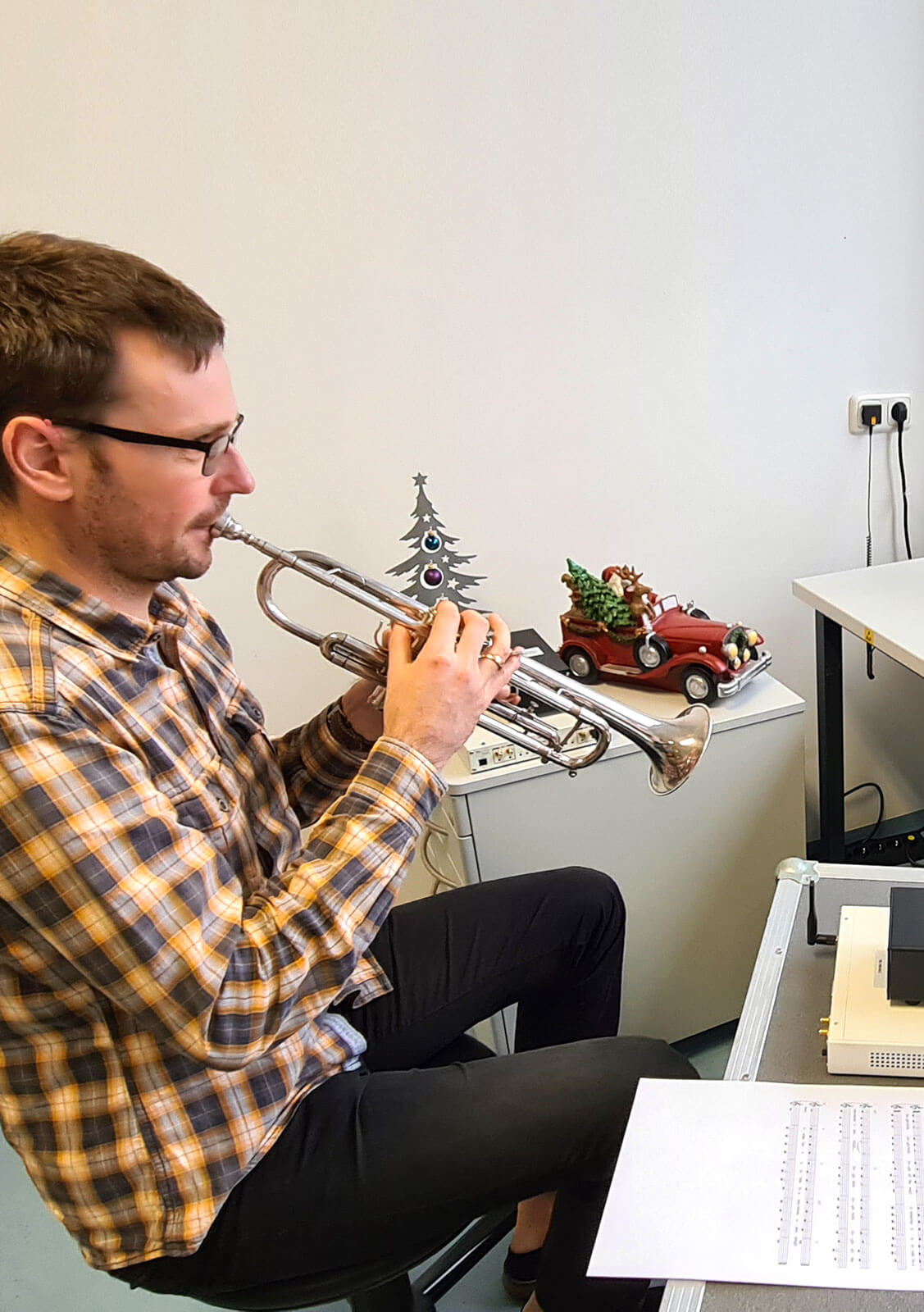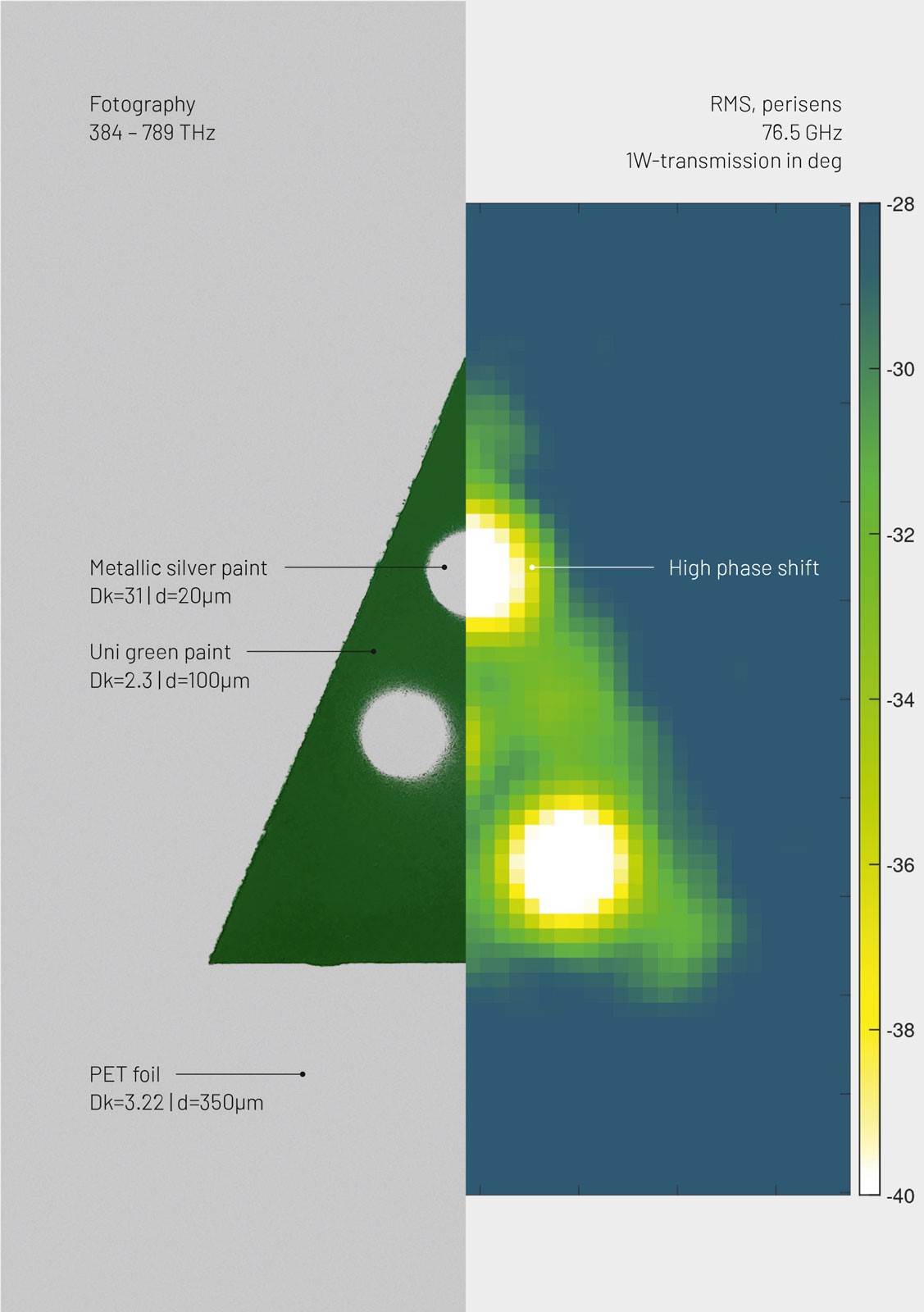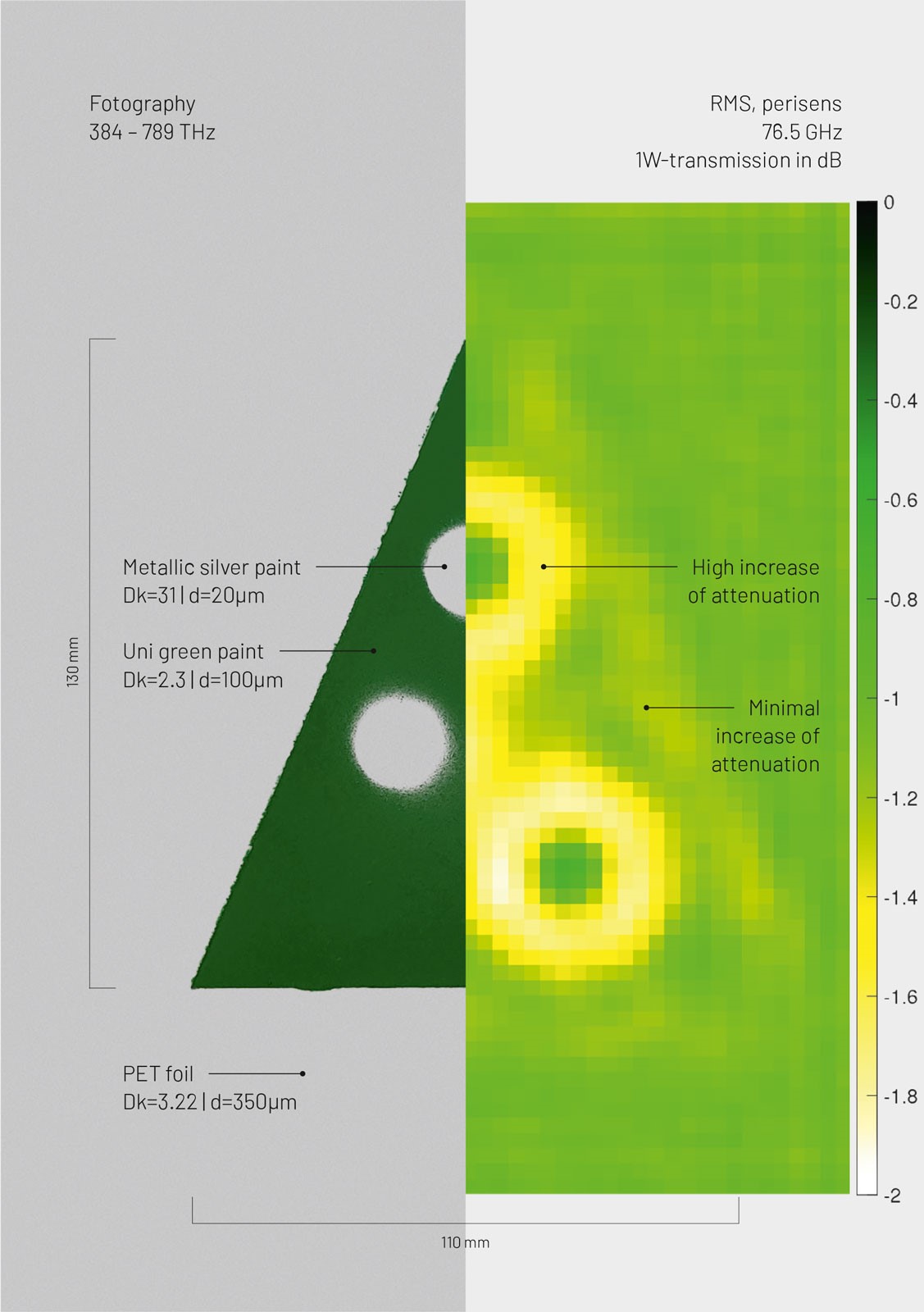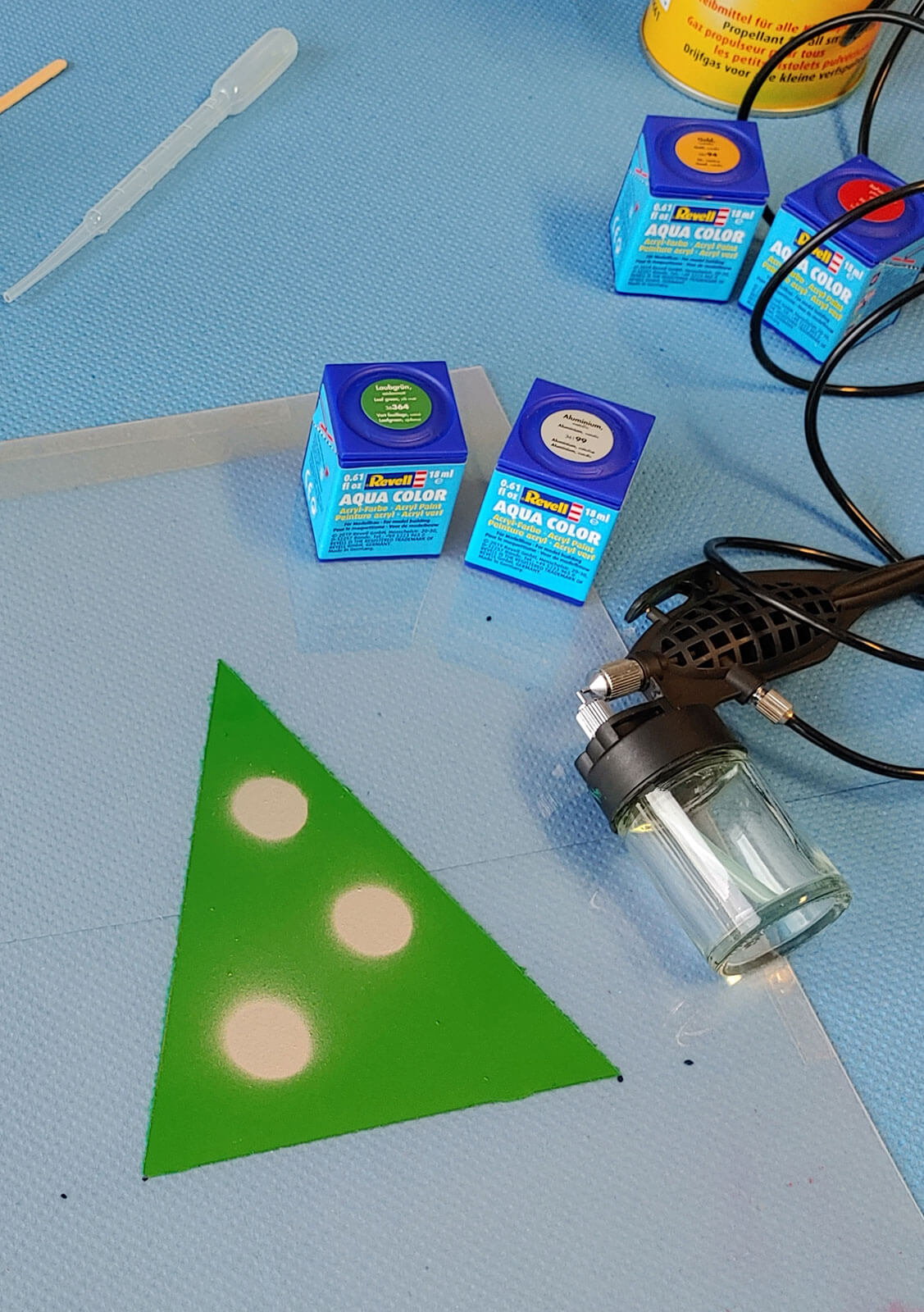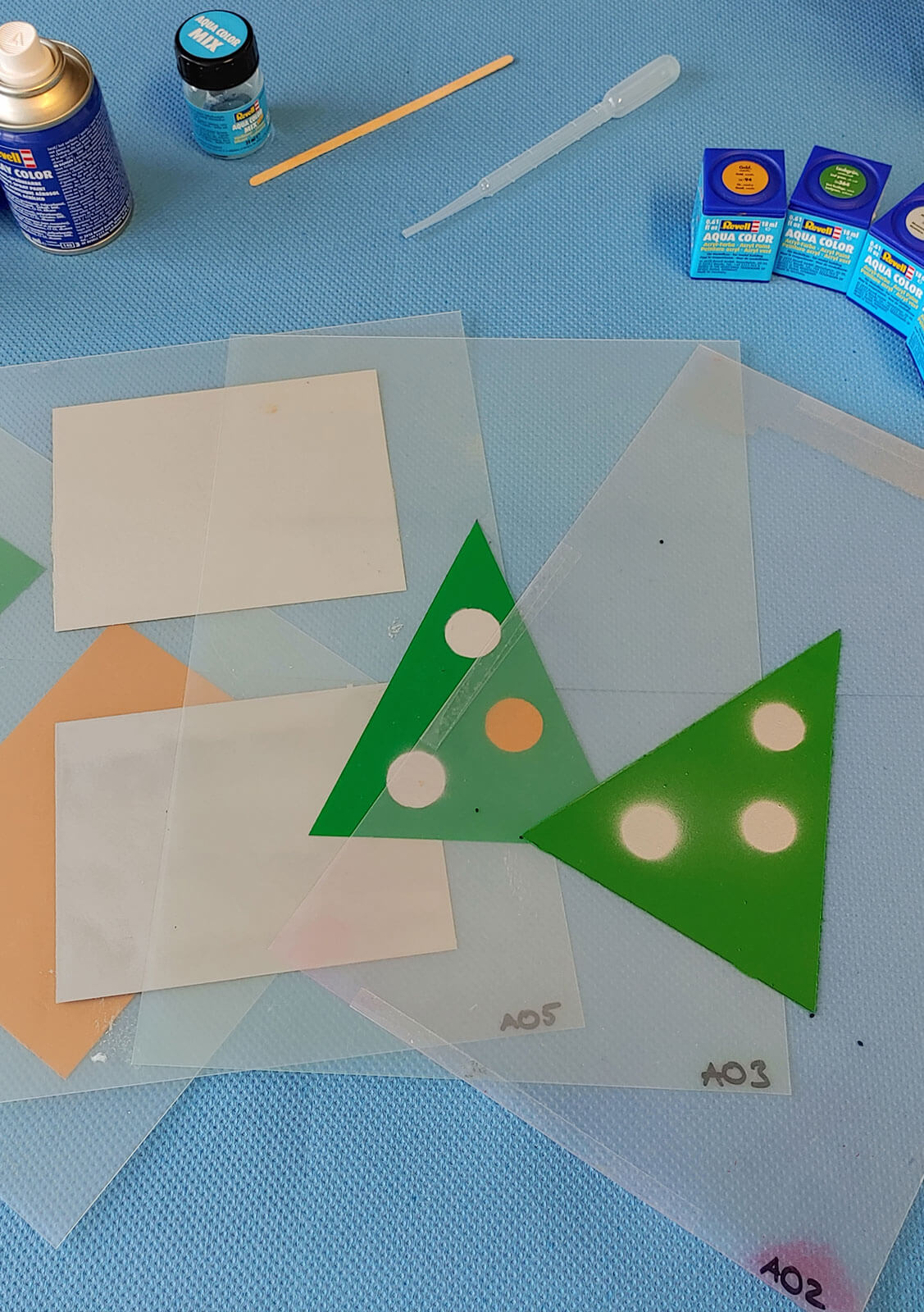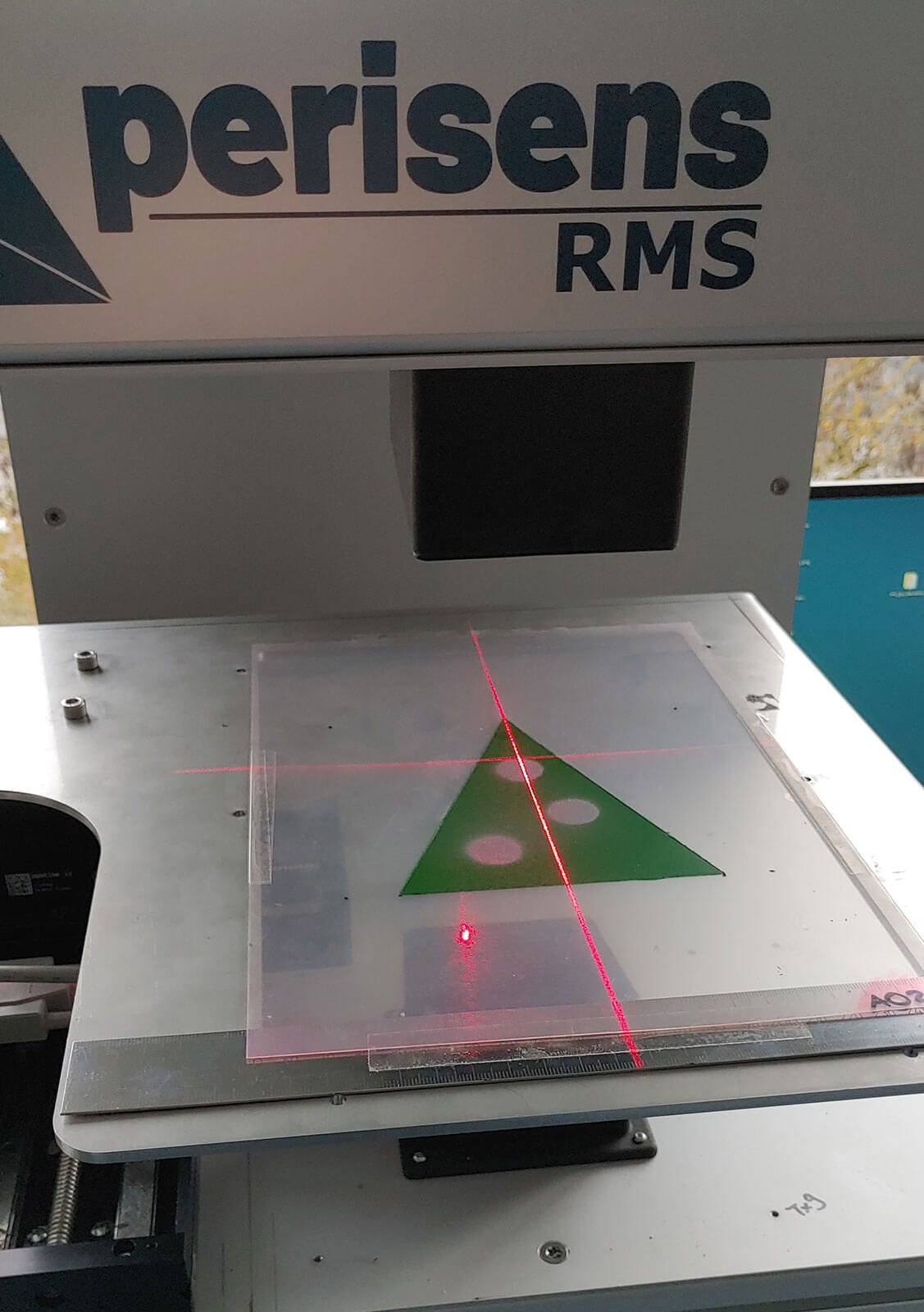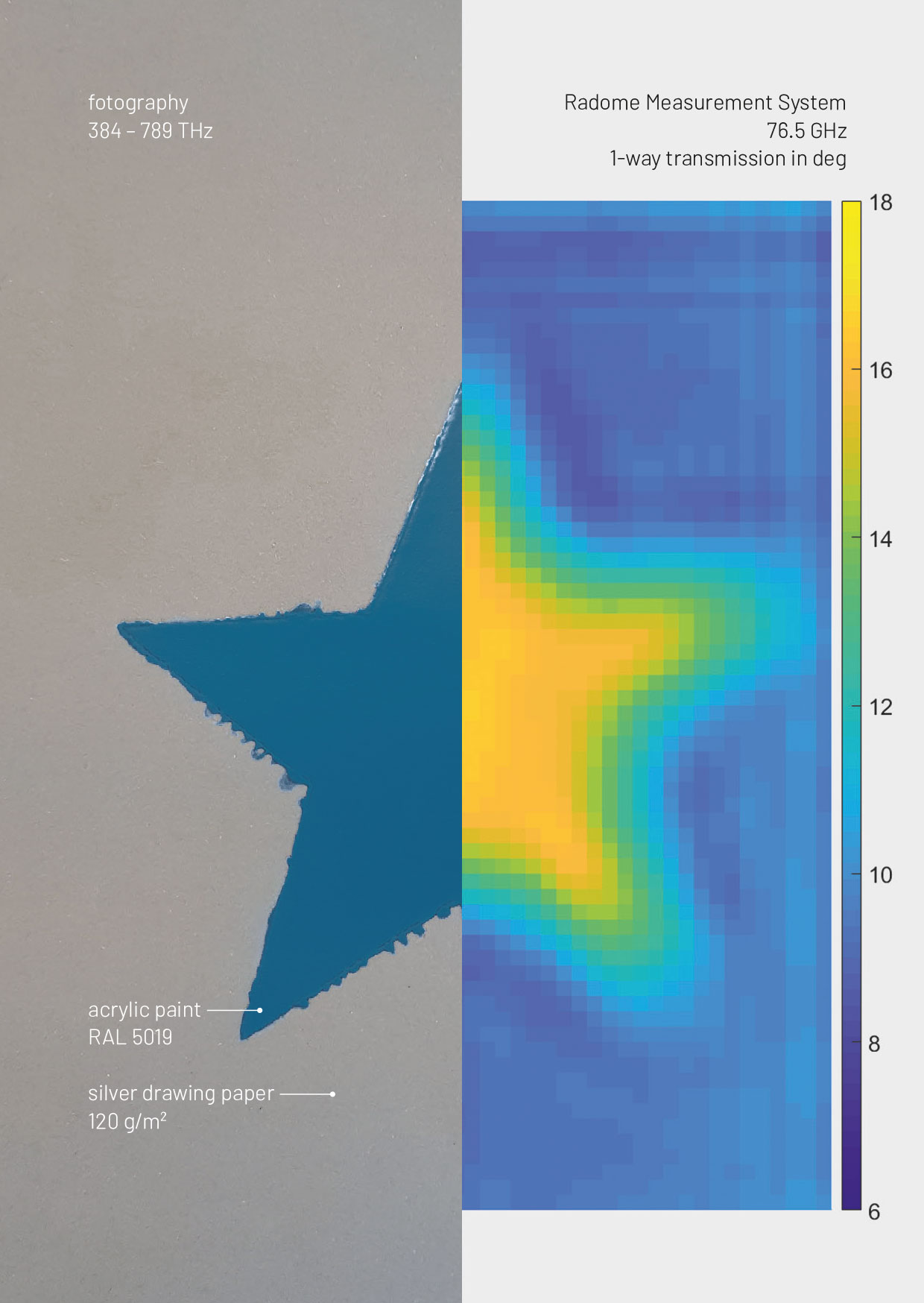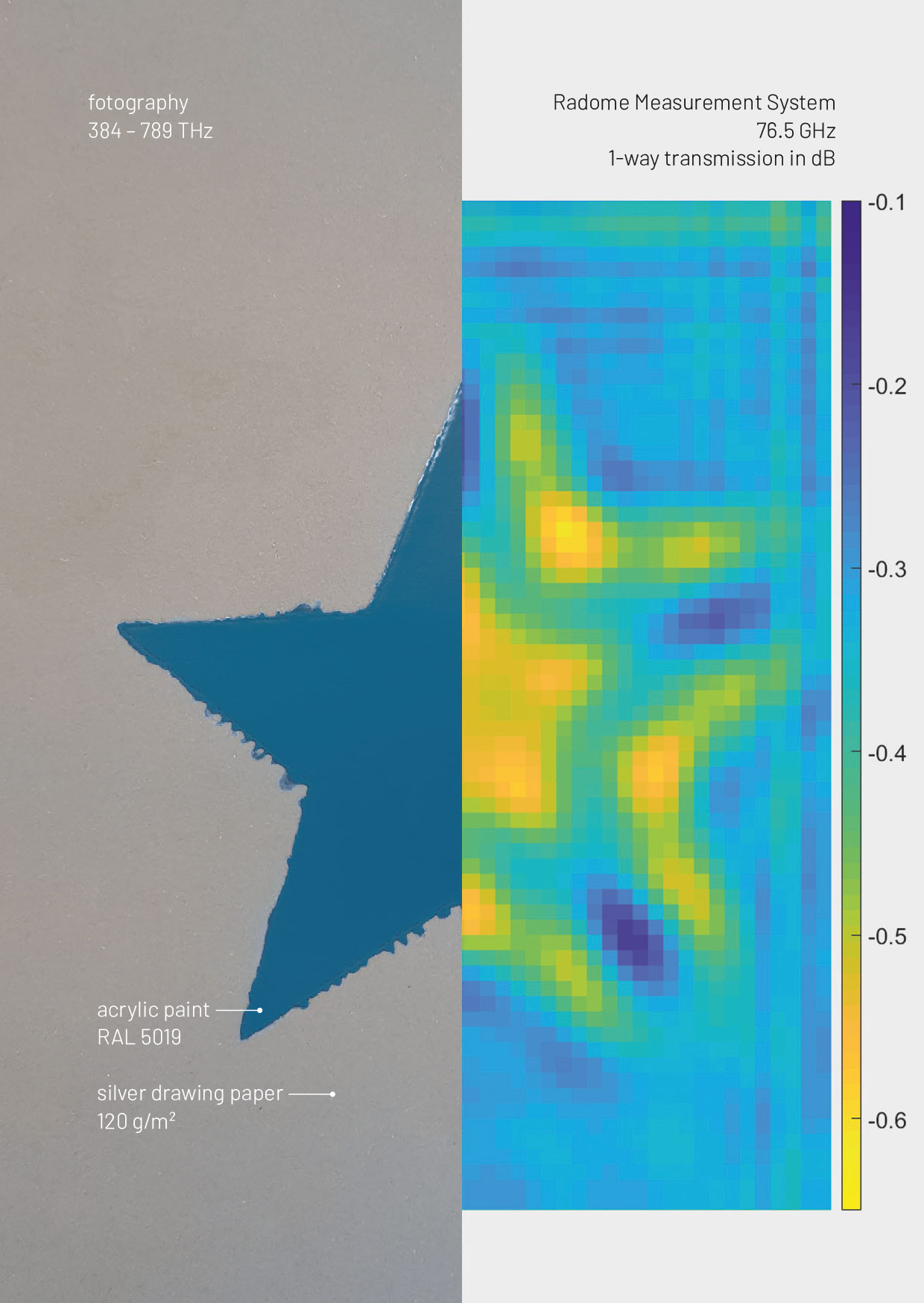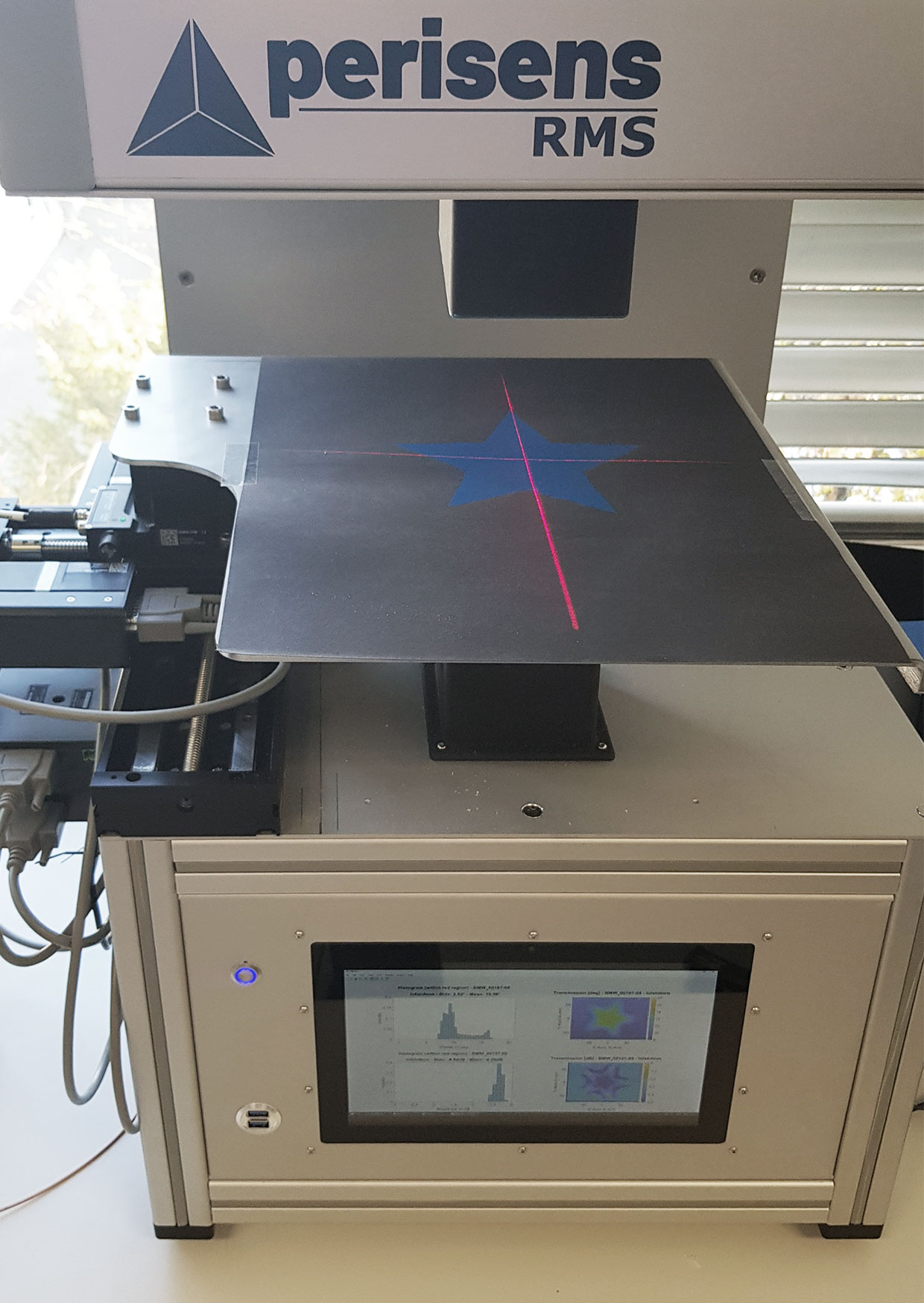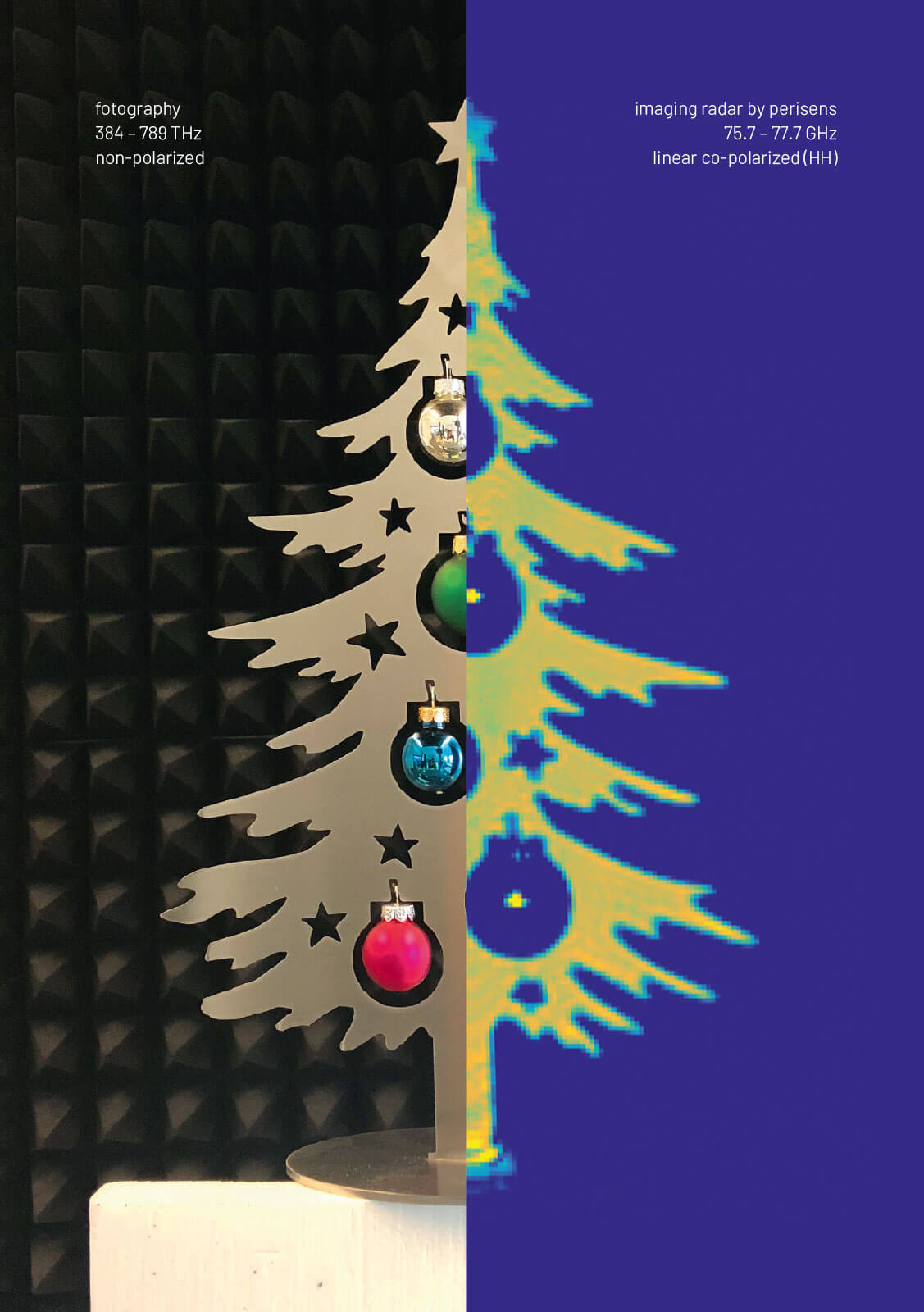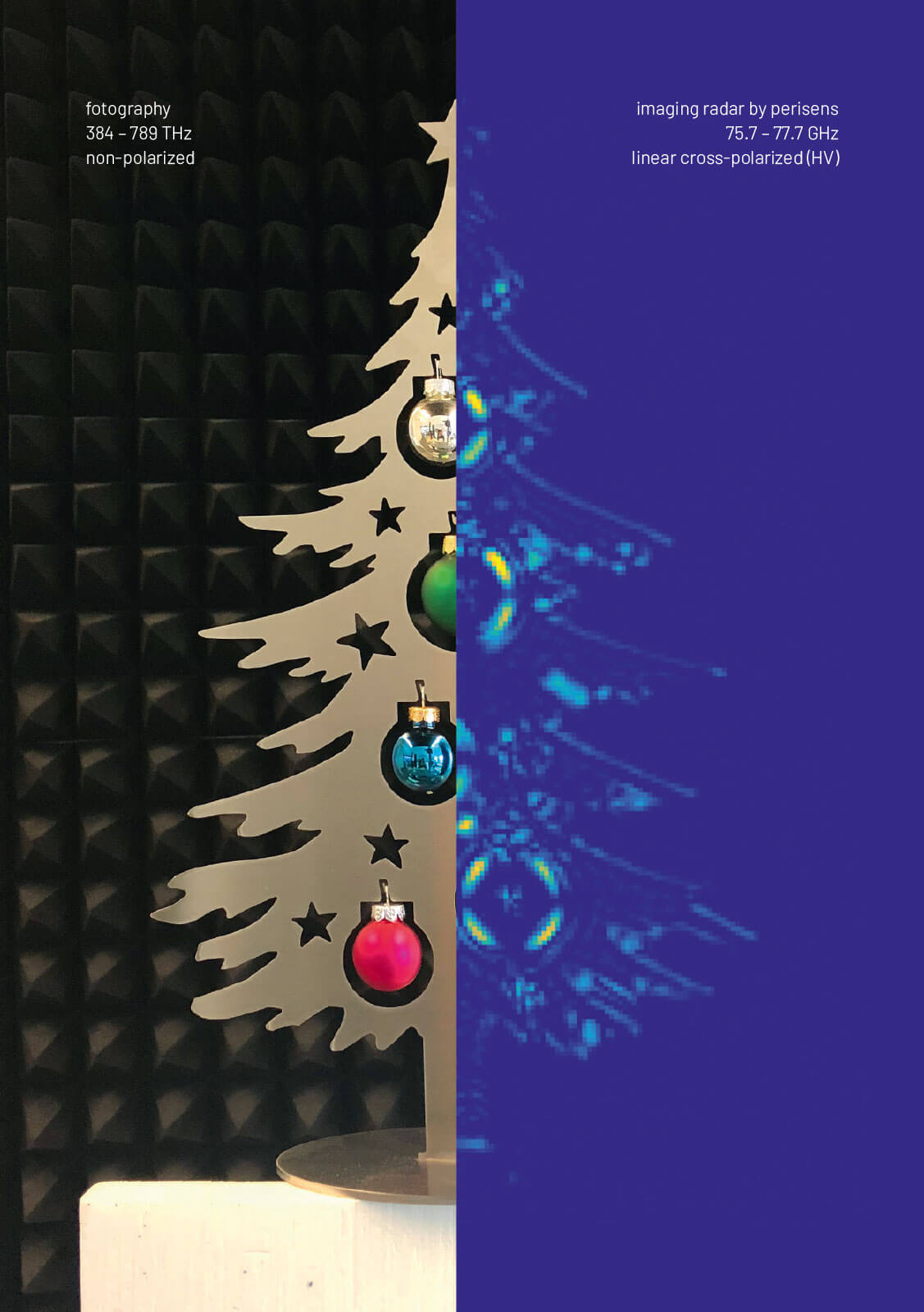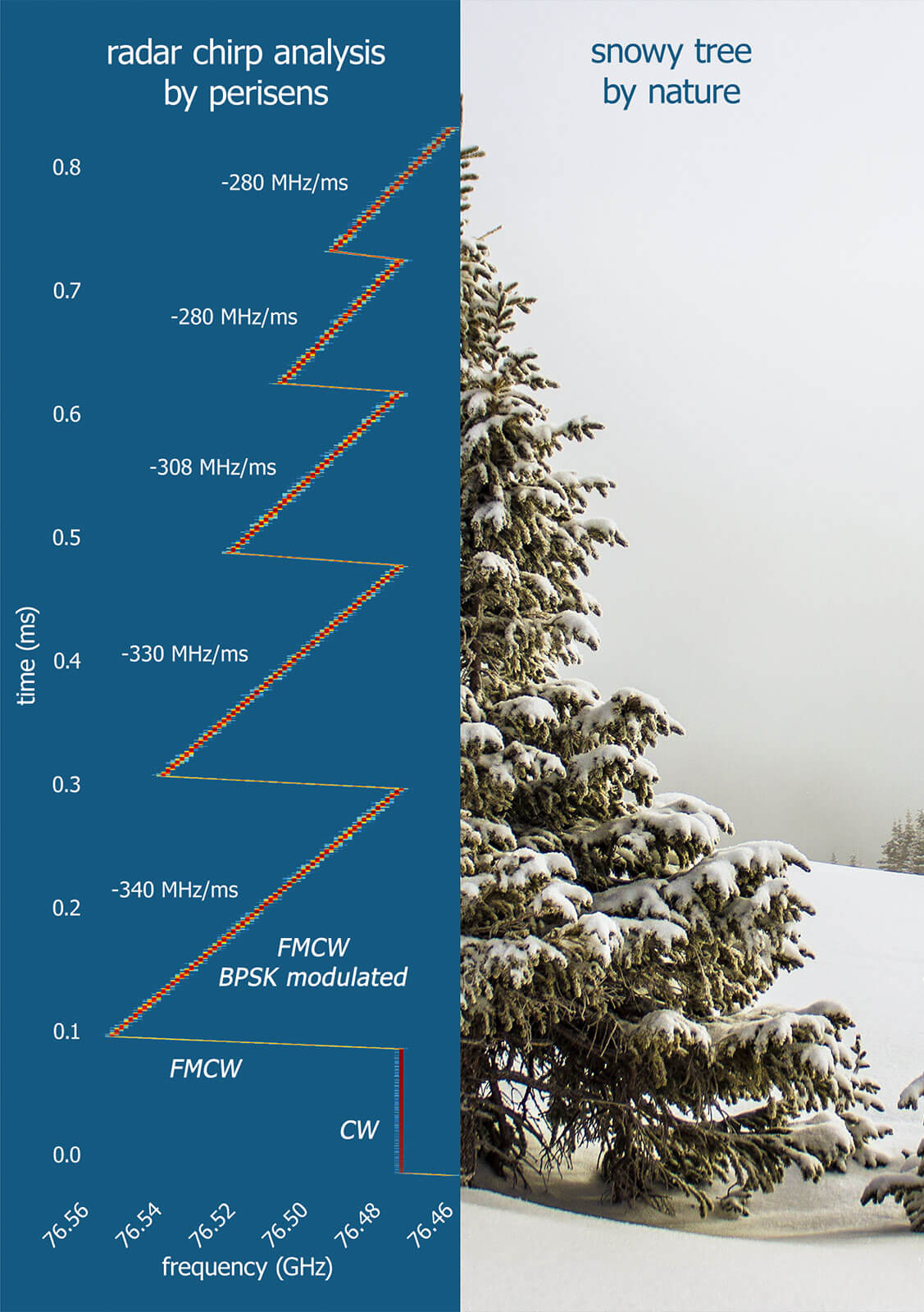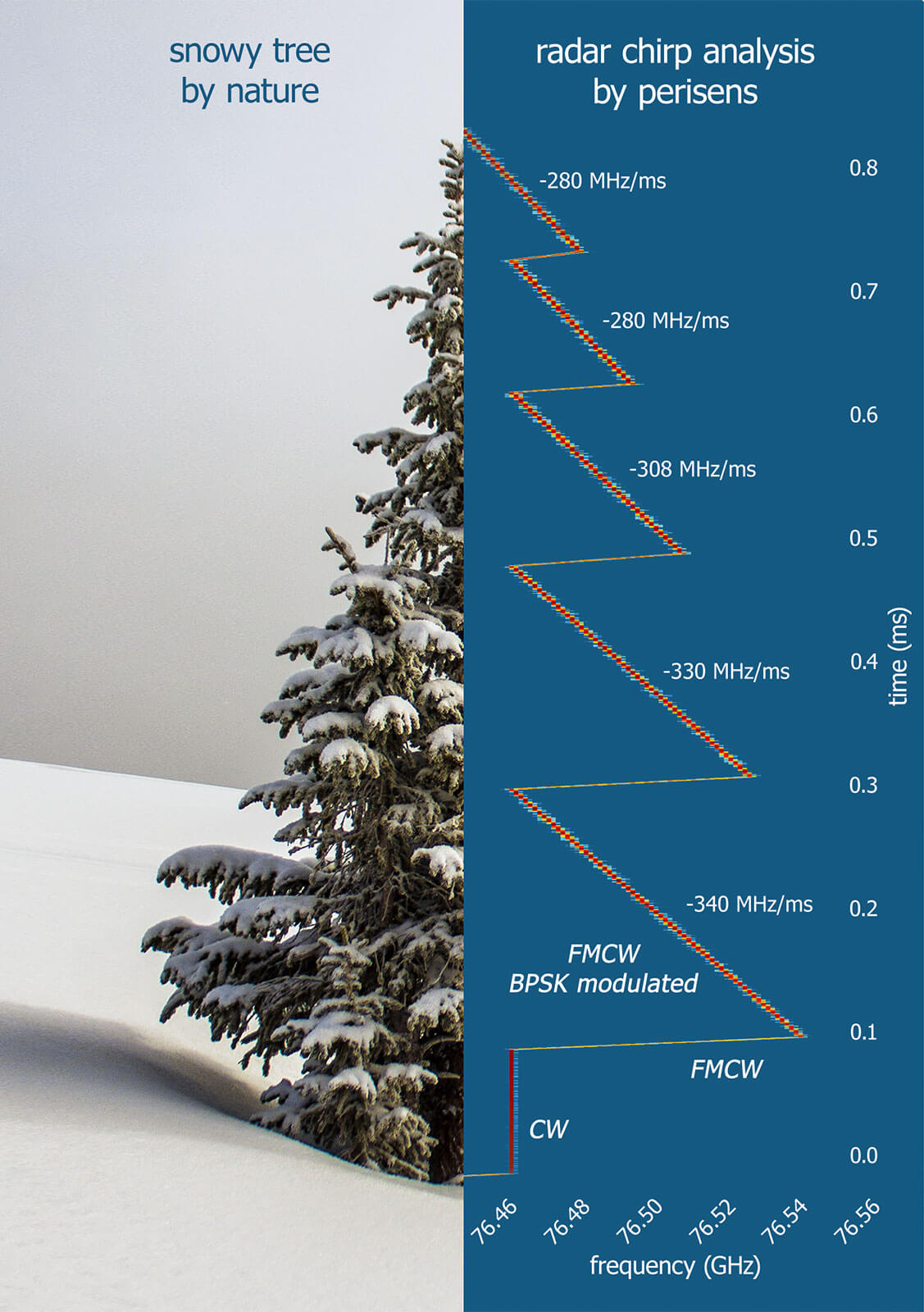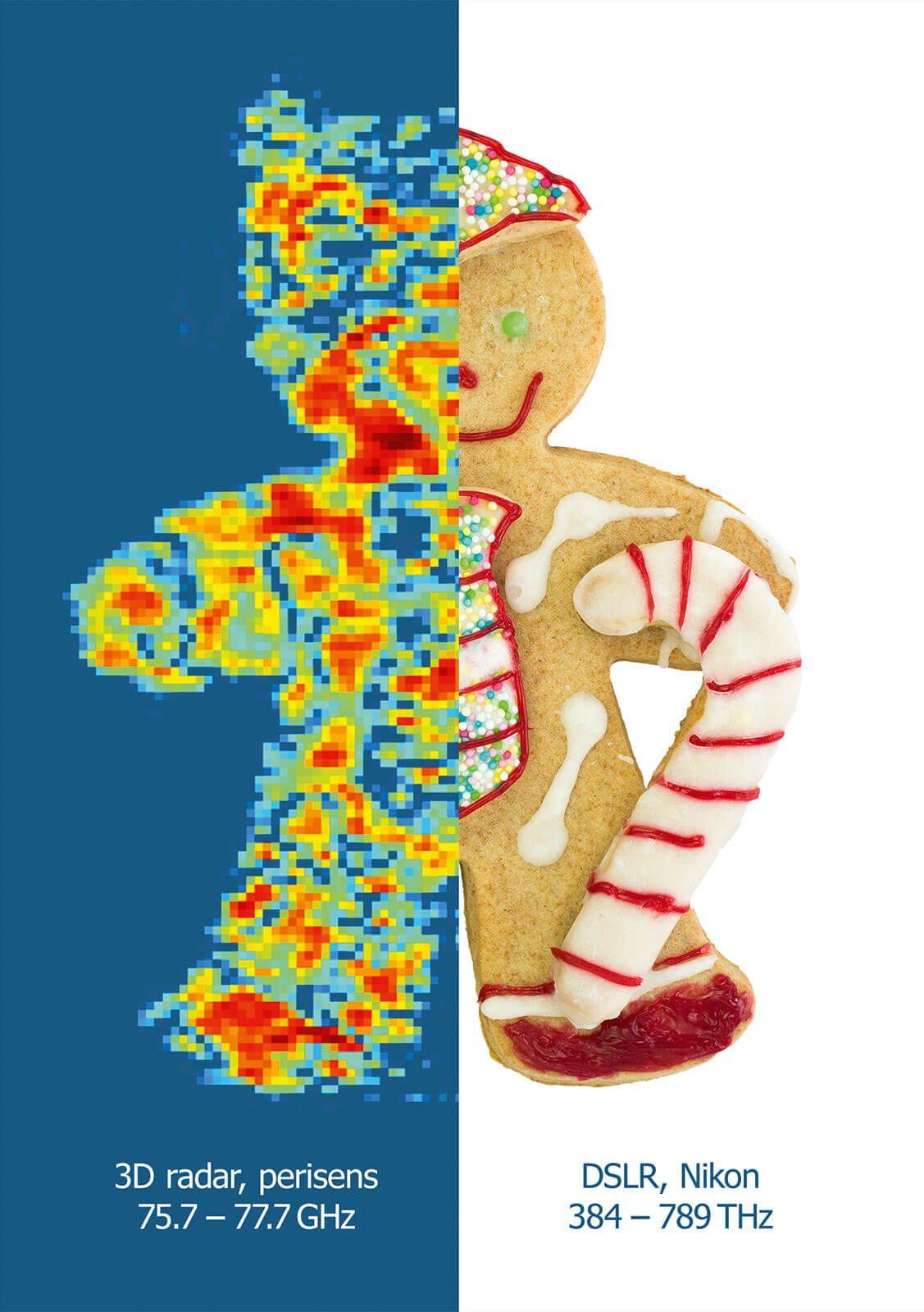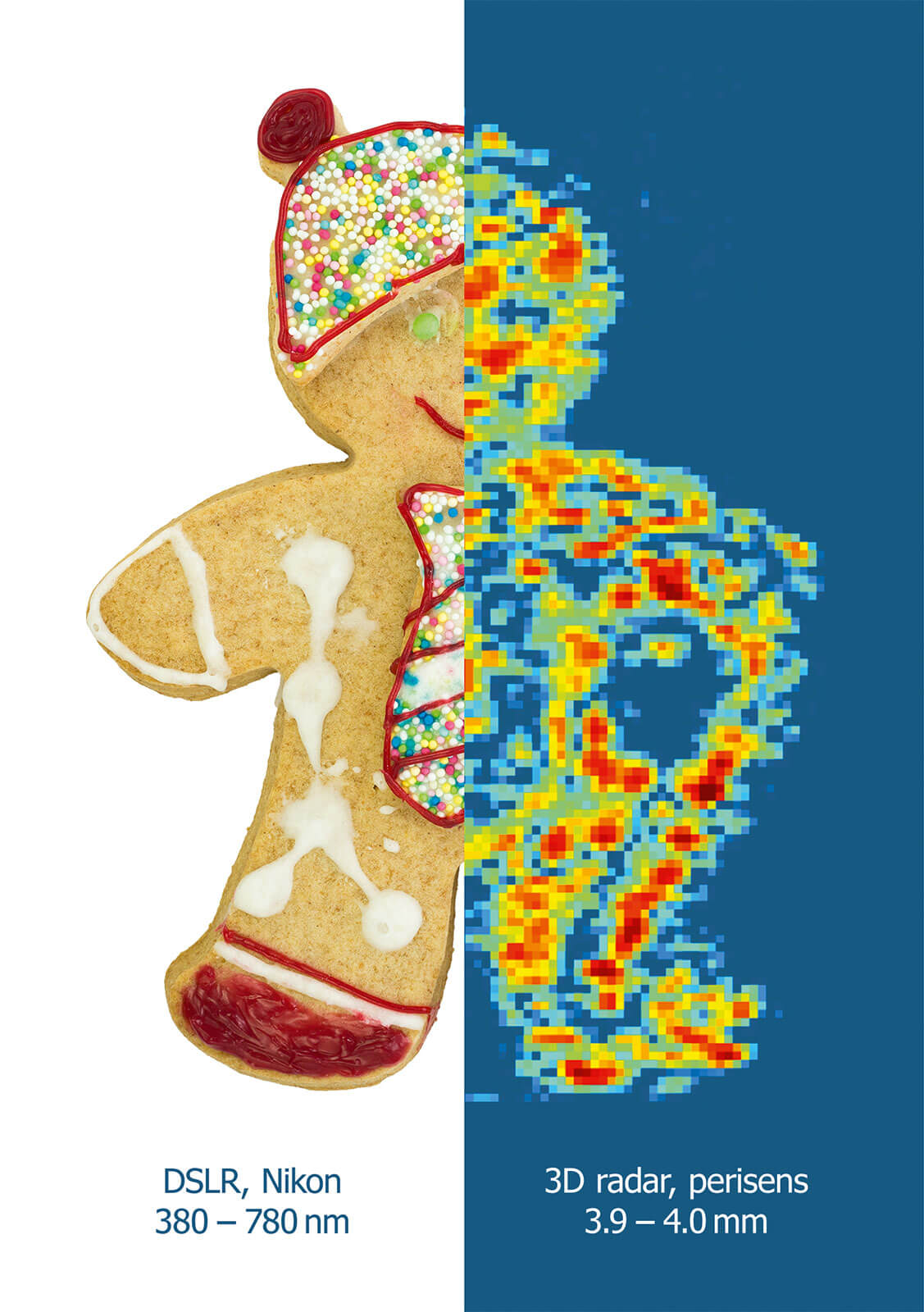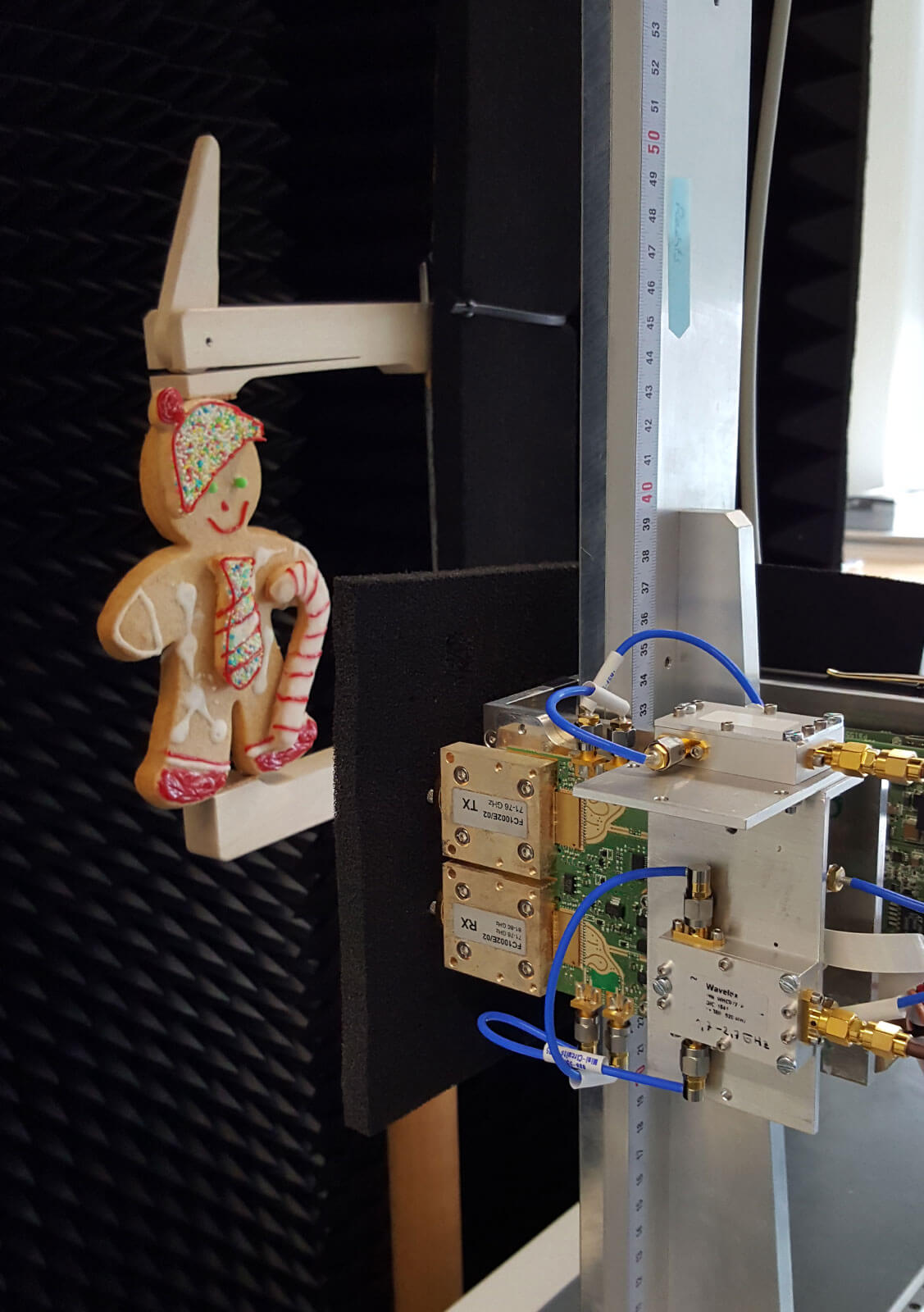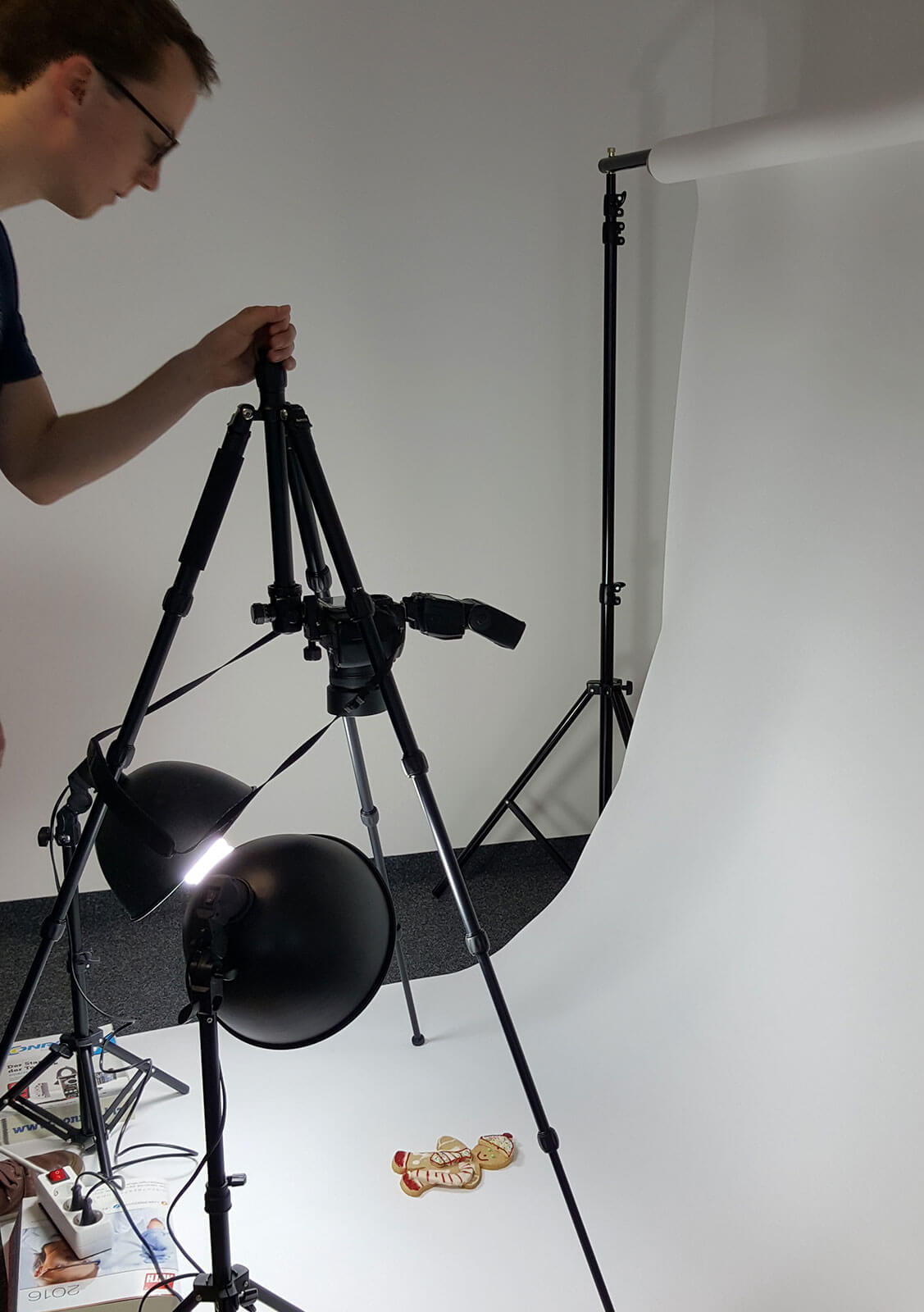Christmas card 2023
This year’s Christmas card shows a high-resolution reflection image of a metallic snowflake measured at 76.5 GHz. The image was generated with the new reflection option of our successful Radome Measurement System RMS-D-77/79G.
The metallic snowflake is scanned line by line with a precision linear stage and a reflection measurement is triggered every 1.6 mm. A high-resolution two-dimensional radar image is then calculated from the more than 24 thousand individual measurements using synthetic aperture radar (SAR) methods. SAR originally comes from remote sensing to measure high-resolution radar terrain maps from satellites or airplanes. Today, SAR methods are also used in automotive radar sensors to generate high-resolution radar maps of the environment almost independent of the weather conditions. The information can be used for automated parking applications, for example. In our measurement system, we use the technology to analyze the reflectivity of radar covers in high resolution. In doing so, we can detect and visualize even smallest defects (inhomogeneities) of about 2 mm size.
Our first Christmas card from 2016 was also measured with an SAR setup. With the integration in our product RMS-D, we are making this measurement available to our customers.
Please do not hesitate to contact us if you have any questions.
Specification of the Christmas card
- Measurement system:
Radome Measurement System (RMS-C-77/79G) with SAR option - Measurement aperture: 255 mm x 245 mm
- Resolution 126 x 126 pixels
- Measurement time: 5 min
- Acquired frequency range: 75 to 78 GHz (millimeter wave range)
Christmas card 2022
For the design of this year’s Christmas card, we were able to win MERCK as a specialist for color pigments. Colored pigments in automotive coatings have a significant influence on their radar behavior.
Due to newly implemented automated driving functions, such as automated overtaking, the requirements for radar sensors are increasing constantly. Since these sensors are typically placed on vehicle corners behind bumpers which are painted in the vehicle color, the radar influence of paints must be considered. Especially, conductive aluminum pigments, can have a negative effect on radar transparency. Our measurement technology provides our customers the ability to optimize their pigments and paints, to ensure optimal radar transparency. Beside research and development, our radar measurement systems are also used in production to test complete bumpers and therefore ensure that the radar sensors have a clean view through the bumper.
The idea for this Christmas card was born from our collaboration with MERCK. The ingredients: a good idea, a bit of ‘masking’ work, some of MERCK’s Meoxal® pigments (Aluminum Substrate based), a few colorants and some binder, 6 application- and masking steps – and all this created a wonderful painted candle. The candle was then measured in our lab with a robot-based Radome Measuring System (RMS) and here is the result…
The radar image shows the one-way transmission through the painted foil. You can clearly see the influence of the paint increasing with higher metal content. The first image shows the phase value, representing the electrical thickness, while the second image shows the transmission of the electromagnetic wave, and thus the attenuation.
Specification of the Christmas card
- Measurement system:
Radome Measurement System (RMS-C-77/79G) with linear stage and robot, perisens - Frequency: 76.5GHz
- Transmission (1way) image with 294 x 234 pixels (pixel size 1.5mm)
- PET foil with Dk=3.22 and d=350um
- Aluminum substrate based Meoxal® paint
With kind support from Merck
Christmas card 2021
Our Christmas card for 2021 shows our WiFi Channel State Information (CSI) analysis while the song “Jingle Bells” was being played with a trumpet.
The CSI is available in the received packet preamble of the OFDM (Orthogonal Frequency Division Multiplexing) based WiFi standards such as IEEE 802.11a/n/ac/ax. Typically, the receiver uses it for channel equalization to recover data and then discards it. But the WiFi CSI is very sensitive to the changes in wireless environment and by processing it over time, it is possible to use the WiFi chip as a sensor. This technology is called WiFi Sensing and its typical applications areas are human presence detection, gesture recognition, intrusion detection and contactless vital signal (breathing and heart rate) monitoring. These applications can be implemented on consumer devices and run parallelly with existing connections, without limiting the data transfer.
For our Christmas card, we created IEEE 802.11ax PHY (Physical Layer) baseband waveform using MATLAB. This waveform is then upconverted, transmitted and received over-the-air using Ettus X300 Software-Defined-Radios (SDRs) in 2.4 GHz band. The received signal was converted back to baseband and analyzed in MATLAB. The WiFi CSI amplitude was plotted in a spectrogram. In the spectrogram we can see the effect of finger movements of our colleague while he was playing “Jingle Bells” with a trumpet. Our WiFi CSI analysis framework uses signal processing algorithms and can perform more tasks, such as detecting and counting breathing movements of a person.
As we see on our Christmas card, the WiFi CSI can even track very small movements in the environment. Currently, access to the WiFi CSI is implemented only on small number of devices, which also limits the number of available applications basing on it. This situation is expected to be change with the upcoming WiFi Sensing standard IEEE 802.11bf and WiFi is expected to become a full sensing paradigm and change the way we interact with devices. Once the WiFi CSI becomes available on customer devices, processing it correctly for the target application will gain high importance.
More information about CSI sensing can be found in our publication “In-Vehicle Breathing Rate Monitoring Based on WiFi Signals” from the European Microwave Week (EuMW2020). Download here.
Specification of the Christmas card
- Measurement system:
Ettus X300 Software-Defined-Radios and Laptop with MATLAB WLAN Toolbox - Center frequency: 2.385 GHz
- Signal bandwidth: 40 MHz
- Packet format: IEEE 802.11ax Single User SISO (Single Input Single Output)
- Antennas: Stub antenna with 3 dBi gain
- Antenna polarization: Vertical
Christmas card 2020
Our Christmas card from 2020 was measured with our Radome Measurement System (RMS-D-77/79G) equipped with a scanning positioning unit.
It shows a spatially resolved 1way-transmission image of a Christmas tree sprayed onto a PET foil in amplitude and phase. The tree is sprayed in uni green and the balls in metallic silver paint. The 100um thick uni paint creates a 6 degree phase shift with minimal impact on the attenuation. The much thinner metallic paint of only 20um creates a phase shift of 10 degree and increases the 1way attenuation by 0.7dB. This shows the strong impact of metallic base coatings. The aluminium pigments in the metallic paint used to generate a visual flip-flop effect significantly increase the electrical density (=permittivity) from ~3 for the uni paint to ~30 for the metallic paint. This increases reflections and reduces the transmission which can become critical, especially for radar sensors used for highly automated driving functions.
Therefore, it is important to investigate the influence of paint and painted surfaces (e.g. bumpers) on automotive radar sensors. The RMS allows characterization of material including automotive paint layers in thicknesses of only 10um. Automotive paint and pigment manufacturer are using the RMS system worldwide to analyze paints properties and develop more radar transparent paints.
Specification of the Christmas card
- Measurement system:
Radome Measurement System (RMS-D-77/79G) with xy linear stages, perisens - Frequency: 76.5GHz
- Transmission image with 51 x 84 pixels (pixel size 3mm)
- PET foil with Dk=3.22 and d=350um
- Unigreen paint with Dk=2.3 and d=100um
- Metallic silver paint with Dk=31 and d=20um
Christmas card 2019
Our Christmas card from 2019 was measured with our Radome Measurement System (RMS-D-77/79G) equipped with a scanning positioning unit.
It shows a spatially resolved 1way-transmission image of a blue star sprayed on silver drawing paper in amplitude and phase. The acrylic paint increases the 1way-attenuation by ~0.3dB and creates a phase shift of ~10degree. Today’s automotive radar sensor are using the phase information of the receiced back reflected wave to derive the target angle (Direction of Arrival). Therefore, it is necessary that a radar cover causes an homogeneous phase shift. Variations of 10deg could affect the angle measurement and would bear the risk of incorrect lane assignment.
The RMS system allows car manufacturer and their supplier to analyze the radar performance of radar covers and to develop radar transparent covers. The RMS systems are also available in an robust alumina housing to perform end-of-line tests of radar covers to ensure the quality in production.
Specification of the Christmas card
- Measurement system:
Radome Measurement System (RMS-D-77/79G) with xy linear stages, perisens - Frequency: 76.5GHz
- Transmission image with 51 x 67 pixels (pixel size 3mm)
Christmas card 2018
Our Christmas card of 2018 shows a radar image of a metal Christmas tree in co- and cross-polarization at 76.5GHz.
The Christmas tree was measured with our Scanning Imaging Radar (SIR) which allows to generate high resolution radar images at 76.5GHz. The first image shows the Christmas tree in co-polarization using receive (RX) and transmit (TX) antennas which are both horizontal polarized. The polarization of an antenna refers to the orientation of the electrical field of an transmitted or received electromagnetic wave. On the radar image you can see the metal surface of the tree and the Christmas balls as a single point (the specular reflection point).
The second image shows the same Christmas tree measured in cross-polarization setup using horizontal polarized TX and vertical polarized RX antennas. Such cross-polarized measurement system can only receive signals from geometries which transform the polarization state of the electromagnetic wave. This happens at diagonal edges which are the only structures visible in the image. Surfaces (as the surface of the tree and the balls) on the other hand, are completely invisible as they do not change the wave polarization.
Today’s radar sensors have co-polarized antennas only. Cross-polarized antenna configurations are currently subject of research. Cross-polarization can provide additional target information which can be used to improve target classification. But as the power of the cross-polarized echo wave is low, this can only work in near range.
Specification of the Christmas card
- Measurement system:
Scanning Imaging Radar (SIR-77G), perisens - Frequency: 76.7GHz
- Transmission image with 100 x 150 pixels (pixel size 2mm)
Christmas card 2017
Our Christmas card of 2017 shows a sequence of frequency ramps at 76.5GHz. Today’s automotive radar sensors are using Frequency Modulated Continuous Wave (FMCW) signals to acquire range and doppler information.
The configuration of the frequency ramps was determined, and the complex baseband data (IQ data) was calculated in MATLAB. In order to make the edges of the tree more visible, the ramps running to the upper right were modulated with a binary phase coding (BPSK with pulse duration of 1us). The modulation broaden the ramp in the frequency spectrum. In modern MIMO (Multiple Input Multiple Output) radar sensors are using phase coding to separate several simultaneous transmit signals in the receiver paths.
The FMCW radar signal was generated with a vector signal generator at an intermediate frequency of 1 GHz. Using a Radar Frequency Converter (RFC), the 1GHz signal was upconverted to the radar band (76.5 GHz) and transmitted via a rectangular horn antenna in our radar laboratory. The radar signal was then received with our Radar Target Simulator (RTS) and analyzed with our Radar Signal Analyzer (RSA). The RSA is connected to the IF output port of the RTS and enables an analysis of FMCW signals.
The linearity of FMCW ramps is crucial for the quality of the raw data of a radar sensor. Our Radar Target Simulators and Radar Signal Analyzer are used to develop future radar sensors. In addition, our devices are used in production to generate highly accurate reference targets for calibrating the sensors.
Specification of the Christmas card
- Measurement system:
Radar Target Simulator (RTS-77/79G) with Radar Signal Analyzer (RSA), perisens - Frequency: 76.7GHz
- FMCW sequence
- Trunk as 100us CW
- Leaf 1 up-ramp of 68MHz in 10us
- Leaf 1 down-ramp of 68MHz in 200us | 1MHz BPSK modulated
- Leaf 2 up-ramp of 56MHz in 10us
- Leaf 2 down-ramp of 56MHz in 170us | 1MHz BPSK modulated
- Leaf 3 up-ramp of 40MHz in 10us
- Leaf 3 down-ramp of 40MHz in 130us | 1MHz BPSK modulated
- Leaf 4 up-ramp of 28MHz in 16.6s
- Leaf 4 down-ramp of 28MHz in 100us | 1MHz BPSK modulated
- Leaf 5 up-ramp of 16MHz in 16.6s
- Leaf 5 down-ramp of 28MHz in 100us | 1MHz BPSK modulated
Christmas card 2016
Our Christmas card from 2016 shows a spatially resolved reflection image measured at the automotive radar frequency of 77GHz measured with our Scanning Imaging Radar.
First, the Christmas boy (in German “Weihnachtsmanschgerl”) was baked with love and decorated artfully. It was then measured in our high-frequency laboratory and photographed. The radar image was measured with a scanning method based on a synthetic aperture radar which is also used for remote sensing in aircraft and satellites.
We use the Scanning Imaging Radar (SIR) to evaluate radar covers (radomes) and to ensure that the radar sensor is not disturbed by its cover. In a joint project with Continental, Volkswagen and TU Muenchen the use of synthetic aperture radar was analyzed for automotive sensors. With the ability to generate very large synthetic apertures during passing a scenery, highly accurate radar environment maps can be generated.
Specification of the Christmas card
3D radar image:
- Measurement system:
Scanning Imaging Radar (SIR-77G) - Measurement aperture 488mm x 646mm
- Resolution 78 561 pixels
- Measuring time: 3h 14min
- Acquired frequency range 75.7 to 77.7GHz (millimeter wave range)
Photography:
- Measurement system: D610 reflex camera, NIKON
- Measurement aperture 4.6mm (50mm lens)
- Resolution 24160256 pixels
- Measuring time: 1/60s
- Acquired frequency range 384 to 789 THz (visible spectrum)

